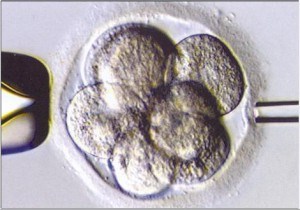Assisted hatching is sometimes recommended to women who have had a failed cycle of In-Vitr o Fertilization (IVF) or a poor prognosis for IVF.
o Fertilization (IVF) or a poor prognosis for IVF.
It is a laboratory technique that may improve the attachment, or implantation, of the early embryo into the uterine wall.
After an egg is fertilized in the laboratory, the cells start dividing forming an early-stage embryo that is contained in a protective layer of proteins or a ‘shell’ called zona pellucida. For successful implantation, the embryo must ‘hatch’ out of this shell and attach to the wall of the uterus for the pregnancy to occur.
Research and past experiences suggest that by creating a small opening in the zona pellucida – either mechanically or chemically – helps the embryo to hatch and implant itself, once transferred in the uterus. Assisted hatching, thereby, in some cases, can increase the chances of a woman becoming pregnant.
Assisted hatching may be beneficial for couples that have had a failed cycle or a poor prognosis for IVF. Advanced maternal age, high levels of the Follicle Stimulating Hormone (FSH) or usage of frozen-thawed eggs can all result in the hardening / thickening of zona pellucida. Additionally, laboratory IVF procedures may contribute to a harder-shell early-stage embryo, as it is not exposed to the fallopian tube’s natural-environment enzymes that ease its hatching.
Assisted hatching is performed in the laboratory, under microscopy, by a specialized embryologist. A small section of the zona pellucida is weakened mechanically by the use of a controlled laser.
The processed embryos are rinsed and returned in the incubator for a few hours before transfer into the uterus on day 3.
How does assisted hatching contribute to the success of assisted reproductive techniques?
Assisted hatching has no influence on the quality of embryos, and thus, although it may improve pregnancy rates, it does not appear to improve live birth rates.
Current studies* indicate that this treatment is no more likely to cause an abnormality to the baby than IVF or Intra-Cytoplasmic Sperm Injection (ICSI) without assisted hatching. Because only the outermost layer is affected by this procedure, the embryo should remain unharmed.
References
* Source: HFEA, January 2015: http://www.hfea.gov.uk/assisted-hatching.html
Assisted hatching has no influence on the quality of embryos, and thus, although it may improve pregnancy rates, it does not appear to improve live birth rates.
Current studies* indicate that this treatment is no more likely to cause an abnormality to the baby than IVF or Intra-Cytoplasmic Sperm Injection (ICSI) without assisted hatching. Because only the outermost layer is affected by this procedure, the embryo should remain unharmed.
References
* Source: HFEA, January 2015: http://www.hfea.gov.uk/assisted-hatching.html


